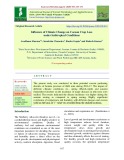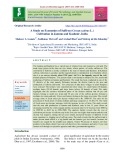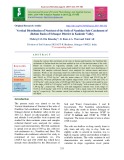
State of Jammu
-
The research study was conducted in Agricultural Zone Bandipora of Jammu and Kashmir state of India. In this research, the adoption of recommended package of practices of rice cultivation by growers were studied. Majority of the growers had adopted nonrecommended variety for sowing. Majority of the growers had adopted less than recommended spacing for transplanting seedlings and do not adopt any seed treatment. Majority of the growers had adopted recommended number of ploughings.
 9p
9p  caygaocaolon7
caygaocaolon7
 18-09-2020
18-09-2020
 9
9
 2
2
 Download
Download
-
The present study was conducted in Agricultural Zone Sopore, Baramulla district of Jammu and Kashmir state. Five villages were selected purposively on the basis of maximum chilli growers present in these five villages. From these five villages respondents were selected by using proportionate allocation method for the study.
 9p
9p  caygaocaolon7
caygaocaolon7
 18-09-2020
18-09-2020
 9
9
 0
0
 Download
Download
-
Sericulture as an industrial sector has been a component of the backbone of Jammu &Kashmir state‟s economy, carrying itself, a rich history. The prevailing climate and availability of skilled labour in the valley of Kashmir are the favourable factors existing for silk production. There are 2,800 villages and 33,000 households which have taken up sericulture as an important economic activity.
 12p
12p  nguaconbaynhay7
nguaconbaynhay7
 15-08-2020
15-08-2020
 12
12
 1
1
 Download
Download
-
The present study was conducted in three potential cocoon producing districts of Jammu province of J&K state during 2016-17. The impact of different climatic conditions viz., spring (March-April) and autumn (September-October) on the incidence of major diseases in silkworm were studied. The results indicated the disease incidence was higher during the autumn rearing as compared to spring rearing. Highly significant correlation of temperature and humidity with different diseases and cocoon yield on the basis of ‘r’ value was recorded from the studied locations.
 5p
5p  caygaocaolon6
caygaocaolon6
 30-07-2020
30-07-2020
 16
16
 1
1
 Download
Download
-
The Jammu and Kashmir has a varied type of climate from sub-tropical to cold arid. The main crops grown in the state are rice, maize, wheat, pulses, oil seeds, saffron etc. The cultivation of Saffron is mostly confined to the state of Jammu and Kashmir. In Kashmir saffron cultivation is peculiar and the legend about its introduction in to Kashmir shows that it is an ancient industry about 2200 years’ old. It is the legendry crop of the welldrained plateau of Pampore. The present study is an attempt to analyse the cost, return and marketing of Saffron in Jammu and Kashmir.
 17p
17p  angicungduoc6
angicungduoc6
 20-07-2020
20-07-2020
 19
19
 1
1
 Download
Download
-
Among the various Sub-catchments in the state of Jammu and Kashmir, the Namblan Subcatchment of Jhelum basin has not been studied in view of the nutrient status of the soils. Based on variations in vegetation, altitude, land use and soil heterogeneity six representative soil profiles were exposed and studied for their depth wise distribution of Nutrient. Soil samples collected thereof, were analyzed for various macro and micro nutrients. While as the increasing trend was followed by the macro-nutrients and micro nutrients. The contents of nitrogen and potassium were in the range of 231.
 7p
7p  kethamoi6
kethamoi6
 29-06-2020
29-06-2020
 7
7
 1
1
 Download
Download
-
The productivity of apple in Jammu and Kashmir is 8.57 metric tons per hectare, when it is compared with the productivity of developed nations of the world this figure is very low and there is plenty of difference in the productivity. In order to curtail this gap a number of factors has to be reviewed seriously and address them priority wise. The factors of prime importance were identified as compatibility of pollen in apple orchards that actually determines the productivity of this most important fruit crop known as king of temperate fruits.
 11p
11p  nguaconbaynhay6
nguaconbaynhay6
 24-06-2020
24-06-2020
 11
11
 1
1
 Download
Download
-
India is home to a great variety of ethno-medicinally important plant species and is ranked sixth among 12 mega-diversity countries of the world (Joshi et al., 2001). Medicinal plants as a group comprises approximately 8000 species and account for around 80% of all higher flowering plant species of India (Samant et al., 2002). The Indian Himalayan Region (IHR) comprises of five biogeographic provinces i.e. Trans, North West, West, Central and East Himalaya and covers approximately an area of 591 thousand km2 (Rodgers and Panwar, 1998).
 19p
19p  quenchua6
quenchua6
 15-06-2020
15-06-2020
 10
10
 1
1
 Download
Download
-
The state of Jammu and Kashmir, a north temperate region of Indian subcontinent, is a rich source of indigenous germplasm. Owing to the rich biodiversity in terms of sheep, goat, camel, yak and poultry, the livestock activity has a contribution of about 11percent in the Gross Domestic Product of the state. It offers promising employment opportunities and handsome economic returns especially in rural mountainous areas of the state. The indigenous livestock populations are very well adapted to various challenges posed due to certain topographic, demographic and other factors.
 9p
9p  angicungduoc5
angicungduoc5
 14-06-2020
14-06-2020
 7
7
 0
0
 Download
Download
-
Poultry production in India has taken a quantum leap in the last four decades, emerging from an entirely unorganized and unscientific farming practice to a commercial production system with state-of-the-art technological interventions. Indian commercial poultry sector has advanced remarkably due to a scientific approach adopted by the industry and an enabling environment created by the Government.
 11p
11p  trinhthamhodang1213
trinhthamhodang1213
 29-05-2020
29-05-2020
 6
6
 0
0
 Download
Download
-
Floriculture has blossomed into commercial activity with a considerable growth and a useful crop diversification option, particularly for small farmers over the past three decades. India has now emerged as second largest grower of flowers after china. In Jammu and Kashmir the practice of flower cultivation at commercial scale by individual growers is at its infancy stage in the state; however commercial cultivation is gradually increasing with boost from the state government.
 6p
6p  trinhthamhodang1213
trinhthamhodang1213
 29-05-2020
29-05-2020
 9
9
 0
0
 Download
Download
-
Free living diazotrophic bacteria bacteria were isolated from the rhizosphere soil of two cultivated rice varieties grown in R. S. Pura and Bishnah blocks of Jammu district of Jammu Division of J&K State. Soil samples were collected from rice rhizosphere at panicle initiation stage. A total of twenty rice grown villages were selected and from each village two composite samples were taken from five plants one each from variety Basmati370 and Ratna through random sampling from each rice growing village of R. S. Pura and Bishnah blocks of Jammu district by using GPS.
 12p
12p  caygaocaolon5
caygaocaolon5
 27-05-2020
27-05-2020
 20
20
 1
1
 Download
Download
-
Ever since man came into being he has been using certain basic techniques for survival with respect to health, hygiene, food, clothing, shelter, agriculture and allied activities. These traditional methods or techniques are called as Indigenous Traditional Knowledge (ITK) of a particular community and present a wide range of information in various aspects of life. Over the last two decades a lot of information has been generated globally with respect to ITK in all walks of life.
 6p
6p  cothumenhmong5
cothumenhmong5
 17-05-2020
17-05-2020
 11
11
 0
0
 Download
Download
-
The state of Jammu and Kashmir has the distinction of producing best quality apples with highest proportion among all member states of Indian state. These apples are usually graded by manual labours of all age groups. The heavy reliance on manual labours and their non-availability at peak season has increased the overall cost of apple production. The existing mechanical graders are bulky, costly, imported and non-portable.
 9p
9p  nguathienthan4
nguathienthan4
 21-04-2020
21-04-2020
 6
6
 0
0
 Download
Download
-
In this study, an in-depth analysis is done with reference to the consumption pattern of fertilizer at Kotli village of R.S. Pura District in the state of Jammu and Kashmir. A total of 79 farmers were randomly without replacement selected and were interviewed with the help of well-structured interview schedule.
 8p
8p  nguathienthan4
nguathienthan4
 18-04-2020
18-04-2020
 21
21
 1
1
 Download
Download
-
The study has been conducted in the state of Jammu and Kashmir where the major fish marketing stakeholders like pre-harvesting contractors, wholesalers, retailers, fish vendors and consumers have been interviewed. The paper has examined and evaluated the investment patterns, profitability and constraints of various intermediaries involved in locally produced exotic carps (grass carp, common carp and silver carp) marketing. Among the wholesalers and retailers of the state the major investment was done in purchasing of deep freezers followed by the storage facilities and others.
 14p
14p  kethamoi4
kethamoi4
 16-04-2020
16-04-2020
 5
5
 0
0
 Download
Download
-
The present investigation entitled analysis of genetic diversity in kale genotypes of Jammu and Kashmir region based on morphological descriptors was carried out in order to reveal the available genetic diversity present in kale genotypes collected from the different kale growing regions of the J&K state including Jammu, Kashmir and Leh and to select the elite genotypes that possess superior leaf yield attributing traits and quality traits. Remarkable variability was present among genotypes for various leaf attributes.
 6p
6p  kethamoi4
kethamoi4
 16-04-2020
16-04-2020
 6
6
 0
0
 Download
Download
-
A study indicates that there is increase in area, production and productivity of major food crops in Jammu & Kashmir State of India over the years but the rate of increase has been slow. Jammu region of the State has maximum cropping intensity (176.8%) followed by Kashmir (123%) and Ladakh (106%). The average land holding in the State is very low (0.66 ha) in comparison to National Average (1.68 ha). The unit farm power availability on gross cropped area basis is 0.78 kW contributed 51.2% by animated (human and animal power) sources and 48.8% from rest of the sources.
 8p
8p  quenchua4
quenchua4
 06-04-2020
06-04-2020
 6
6
 0
0
 Download
Download
-
Apricot (Prunus armeniaca L.) is the most important fruit crop of Ladakh district in the state of Jammu and Kashmir and it is grown in the lower belt areas (Takmachik and Lehdo) of Ladakh. Apricot has some comparative benefits and advantages which is the result of different relief. This study reveals the production level (quantity and quality), costs (investment and production costs- divided into material cost and human costs) profit and overall investment.
 5p
5p  quenchua4
quenchua4
 06-04-2020
06-04-2020
 7
7
 0
0
 Download
Download
-
The J&K is hilly state with rural and tribal masses keeping poultry as a tradition for their livelihood since time immemorial. They rear desi chicken with low egg and meat production in backyard system. For developing the rural poultry farming, improved backyard poultry birds rearing is of very important.
 5p
5p  cothumenhmong4
cothumenhmong4
 25-03-2020
25-03-2020
 8
8
 0
0
 Download
Download
CHỦ ĐỀ BẠN MUỐN TÌM
































